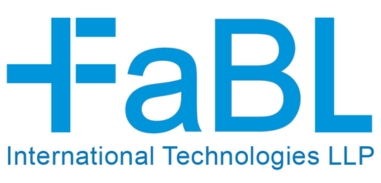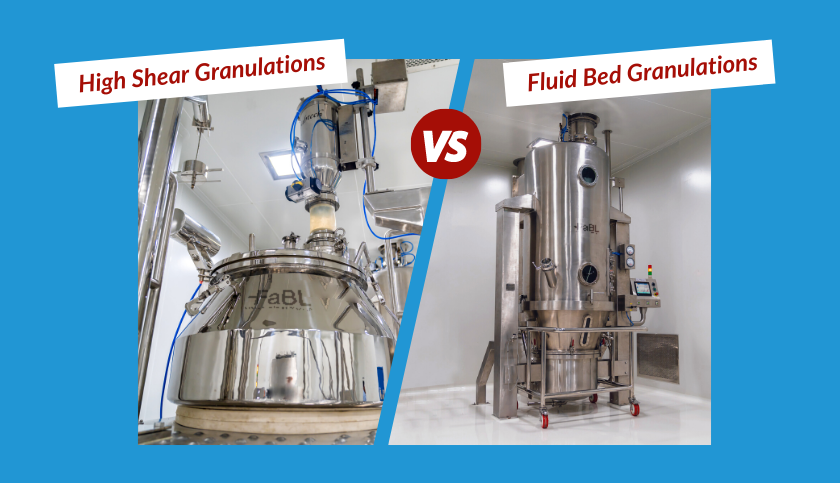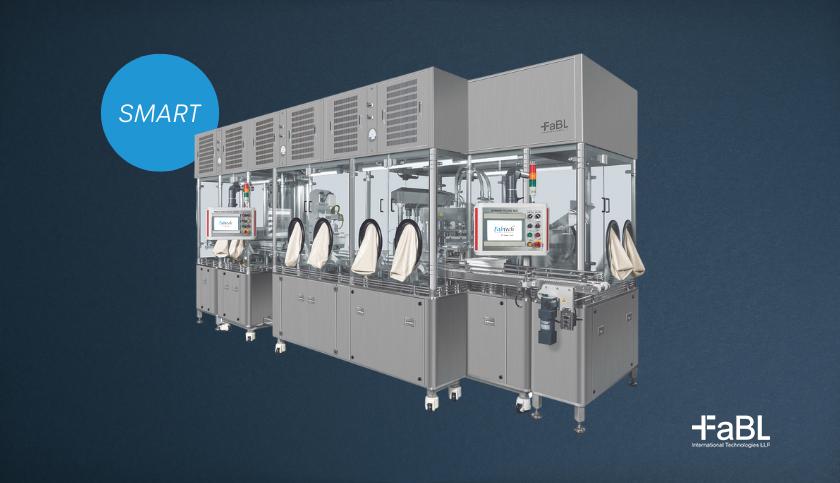Granulation that forms the core component of the pharmaceutical industry continues to grow with improved technologies and accelerated advancement. Apparently, High Shear Granulation (HSG) technique that offers an enhanced shaping process has been widely accepted as the optimum choice of tablet granulation method. Considering its slow moving heavy duty beater assembly coupled with a fast rotating chopper, HSG has stood out for being the most favoured choice by drug manufacturers.
However, in the recent decades, the Fluid Bed technology (FBG) with Top or Bottom Spray has also been looked at as an effective alternative to the High Shear route and gained significant popularity amongst the wise and discerning pharma manufacturers.
High Shear Granulation involves extensive “kneading” that results in dense granulation which is further chopped into smaller sized wet granules before proceeding for drying. The efficacy of this methodology lies in its ability of accepting all kinds of dry mix and be able to yield granulation with good properties. It is perhaps this attribute that has made a wide section of users to believe HSG is the optimum choice of granulation. The dense granules production, high bulk density and less amount of fines have contributed to better tablet performance and has given it a distinct edge over other processes.
While the said facts and opinions can hardly be denied, in practice it is observed that the conventional HSG proponents keep the Fluid Bed Granulation (FBG) method at bay primarily out of fear of uncertainties that may arise from the FBG method, especially in terms of their adaptability to most powder treatment requirements. This holds true as most plants have HSG as the mainstay approach with FBG being kept as an alternative or a second granulation suite for a smaller group of products. This seems to be the result of a strong resistance to change and “Not wanting to rock the Boat”.
The most important characteristic of FBG is its adaptability to almost every powder mix, high dose or low dose drugs and excipient mixture, and any solvent or mix of solvents.
The other advantages of the FBG can be briefly stated as under:
- Totally Closed System
- Reduced number of accessories and supporting equipment
- Seldom need for dry milling in a carefully controlled process
- Less requirement of associated equipment as opposed to HSG line
Moreover, High Shear Granulation involves bulk amounts of binder paste that are laid out using the kneader/beater to obtain large sized wet chunks. The same is further broken down into smaller size wet granules/smaller chunks with the aid of the fast rotating Chopper. The entire sequence is short circuited in a FBG that sprays the binder in a very fine spray, thus wetting powders entirely, as opposed to huge wet lumps containing dry powder mix inside the lumps. This is followed by the drying process in which the smaller wet particles stick to each other (due to capillary action caused by evaporating moisture) forming smaller granules directly. This to a large extent helps in getting away from dry milling in a carefully controlled process.
How to get denser granules from a FBP?
Contrary to belief, it is virtually possible to get any bulk density that one desires by manipulating the humidity of the processing air. It is also possible to control the level of aeration by controlling the atomizing pressure and use of co/ or counter current spray modes too. In general, due to the counter current spray system, as in a top spray mode of FBP, granules with a lower bulk density can be obtained, while a HSG route may be taken for granulations that require higher bulk density (for appropriate die filling). Here, the advantage of supplying Humid Inlet Air (RH of the air can be programmed according to one’s requirement) must also be considered so as to avoid spray drying of the counter current spray, thus leading to denser particulate agglomeration. Infact, many publications in the past have claimed the correlation of the RH setting of Inlet air with the final BD of desired dried granules and also stated that the relation can be programmed in the plc system itself.
A modern approach now would be to use the bottom spray (sans the Wurster) or the Tangential Roto Bed Granulator (FRG) that stands superior by virtue of its naturally yielding denser granulates.
Typically, a process comparison in timings would be like this-
| S.No | Operation Seq and timings | High Shear Granulation` | Fluid Bed Granulation (Top / Bottom / Roto) |
| 1. | Loading | By dumping or through VTS | By suction |
| 2. | Dry Mixing | 10 to 20 mins | Typically 3 to 5 |
| 3. | Wet Mixing | 10 to 20 mins | 7 to 15 mins |
| 4. | Wet Co mill & trf to FBD | 10 mins | NIL |
| 5. | FB Drying | 45 to 60 mins | 45 to 60 in the same equip. No transfer at all |
| 6. | Use of solvents | Can be used if required | Can be used if required |
Binders used commonly in a FBG are:
- Starch paste of consistency 5 to 10% (thin and easy to pump and spray)
- Povidone solutions 6 to 10 %
- Hydroxy Propyl Cellulose 6 to 8 %
- Diluted solutions of Gums and other cellulosic substances can also be used.
Incorporation of colours/low dose drugs dispersed/dissolved in the spray solution allows for deeper and more uniform penetration as opposed to in a HSG set up.
Granulation that forms the core component of the pharmaceutical industry continues to grow with improved technologies and accelerated advancement. Apparently, High Shear Granulation (HSG) technique that offers an enhanced shaping process has been widely accepted as the optimum choice of tablet granulation method. Considering its slow moving heavy duty beater assembly coupled with a fast rotating chopper, HSG has stood out for being the most favoured choice by drug manufacturers.
However, in the recent decades, the Fluid Bed technology (FBG) with Top or Bottom Spray has also been looked at as an effective alternative to the High Shear route and gained significant popularity amongst the wise and discerning pharma manufacturers.
High Shear Granulation involves extensive “kneading” that results in dense granulation which is further chopped into smaller sized wet granules before proceeding for drying. The efficacy of this methodology lies in its ability of accepting all kinds of dry mix and be able to yield granulation with good properties. It is perhaps this attribute that has made a wide section of users to believe HSG is the optimum choice of granulation. The dense granules production, high bulk density and less amount of fines have contributed to better tablet performance and has given it a distinct edge over other processes.
While the said facts and opinions can hardly be denied, in practice it is observed that the conventional HSG proponents keep the Fluid Bed Granulation (FBG) method at bay primarily out of fear of uncertainties that may arise from the FBG method, especially in terms of their adaptability to most powder treatment requirements. This holds true as most plants have HSG as the mainstay approach with FBG being kept as an alternative or a second granulation suite for a smaller group of products. This seems to be the result of a strong resistance to change and “Not wanting to rock the Boat”.
The most important characteristic of FBG is its adaptability to almost every powder mix, high dose or low dose drugs and excipient mixture, and any solvent or mix of solvents.
The other advantages of the FBG can be briefly stated as under:
- Totally Closed System
- Reduced number of accessories and supporting equipment
- Seldom need for dry milling in a carefully controlled process
- Less requirement of associated equipment as opposed to HSG line
Moreover, High Shear Granulation involves bulk amounts of binder paste that are laid out using the kneader/beater to obtain large sized wet chunks. The same is further broken down into smaller size wet granules/smaller chunks with the aid of the fast rotating Chopper. The entire sequence is short circuited in a FBG that sprays the binder in a very fine spray, thus wetting powders entirely, as opposed to huge wet lumps containing dry powder mix inside the lumps. This is followed by the drying process in which the smaller wet particles stick to each other (due to capillary action caused by evaporating moisture) forming smaller granules directly. This to a large extent helps in getting away from dry milling in a carefully controlled process.
How to get denser granules from a FBP?
Contrary to belief, it is virtually possible to get any bulk density that one desires by manipulating the humidity of the processing air. It is also possible to control the level of aeration by controlling the atomizing pressure and use of co/ or counter current spray modes too. In general, due to the counter current spray system, as in a top spray mode of FBP, granules with a lower bulk density can be obtained, while a HSG route may be taken for granulations that require higher bulk density (for appropriate die filling). Here, the advantage of supplying Humid Inlet Air (RH of the air can be programmed according to one’s requirement) must also be considered so as to avoid spray drying of the counter current spray, thus leading to denser particulate agglomeration. Infact, many publications in the past have claimed the correlation of the RH setting of Inlet air with the final BD of desired dried granules and also stated that the relation can be programmed in the plc system itself.
A modern approach now would be to use the bottom spray (sans the Wurster) or the Tangential Roto Bed Granulator (FRG) that stands superior by virtue of its naturally yielding denser granulates.
Typically, a process comparison in timings would be like this-
| S.No | Operation Seq and timings | High Shear Granulation` | Fluid Bed Granulation (Top / Bottom / Roto) |
| 1. | Loading | By dumping or through VTS | By suction |
| 2. | Dry Mixing | 10 to 20 mins | Typically 3 to 5 |
| 3. | Wet Mixing | 10 to 20 mins | 7 to 15 mins |
| 4. | Wet Co mill & trf to FBD | 10 mins | NIL |
| 5. | FB Drying | 45 to 60 mins | 45 to 60 in the same equip. No transfer at all |
| 6. | Use of solvents | Can be used if required | Can be used if required |
Binders used commonly in a FBG are:
- Starch paste of consistency 5 to 10% (thin and easy to pump and spray)
- Povidone solutions 6 to 10 %
- Hydroxy Propyl Cellulose 6 to 8 %
- Diluted solutions of Gums and other cellulosic substances can also be used.
Incorporation of colours/low dose drugs dispersed/dissolved in the spray solution allows for deeper and more uniform penetration as opposed to in a HSG set up.
To recapitulate, it is heartening to see pharma plants world-over now having only FBG as their main granulation strategy for its cost and space advantage especially in newer units. Moreover, today’s newer generation Fluid Bed equipment offers much more advanced spray granulators with Roto and bottom spray configurations that deliver enhanced usability, speed and efficiency.




